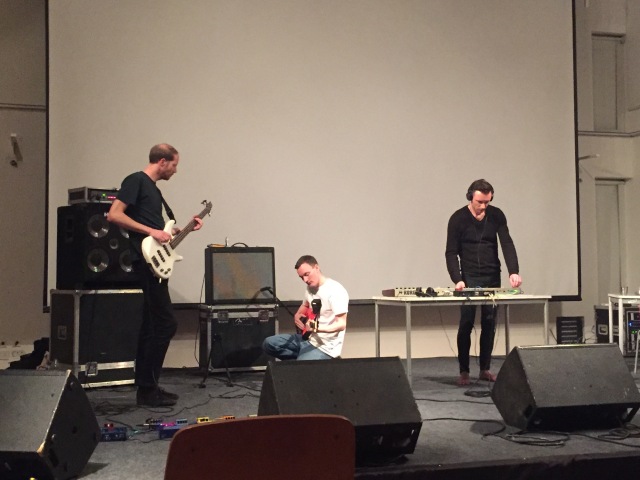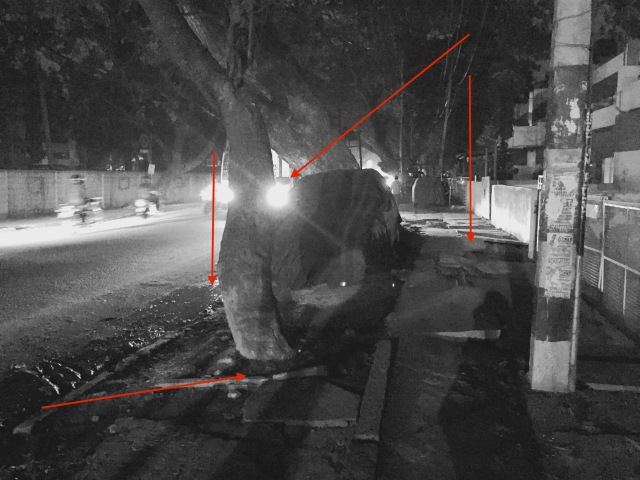
Flyer: Goethe-Institut / a certain object
Subject | Object Formation
a certain object is a multifaceted collaboration between Alfons Knogl, Holger Otten, and occasionally Daniel Ansorge, each having a strong artistic presence in various mediums
Otten and Ansorge came together in 2015 for Perspektive 02, the second in a series of exhibitions curated by Otten and Lars Breuer held at the Ludwig Forum Aachen (Cologne). Otten sought to exhibit artists working in groups or fields not typically represented in the traditional gallery space. Perspektive 01 was a collaboration with a Dusseldorf publishing house and Otten felt the image based content from Magazine, a record label run by Ansorge, Jens-Uwe Beyer, and Crato would make an interesting continuum of the series.
Magazine
Unlike most record labels, Magazine began as a visual concept. The idea took shape in 2007 when Crato (John Harten), a graphic designer by training, wanted an outlet to recontextualize his vast image-based archive of objects, materials, landscapes, science-y things, film stills, photographs of artwork, architecture, the explosive, and the mundane. Images vastly different from one another yet united by a certain level of provocativeness.
Ansorge told the Bangalore audience that at that point the only solid idea was an archival aspect of a series, not necessarily a music label. Indeed one can imagine that Beyer, who operates under the alias Popnoname, was busy with Kompakt, the Cologne label that exploded the techno scene in the 2000s and Ansorge, best known as Barnt, was busy blowing dance floor minds with his DJ sets.
But Ansorge was taken with the tactility of the record and the cover. “An opportunity to do something, not just cover something,” he explained. This perfect square would act as a canvas for Crato’s recontextualized visuals, each release would be a reinterpretation of the exhibition, a new take on curation. Thus the conceptual dimension of Magazine evolved.
Beyer and Ansorge struggled to find the musical identity for the label and during the talk Ansorge implied that solidifying a particularly musical identity was eventually dropped, a point discovered by listening to each release; it is hard to ascribe a particular identity to the sonancy of Magazine.
Magazine 01 was released in 2010 and limited to 300 records. Keeping true to the concept, each record features a series of curated images on the record cover, with no reference to the artist. Textual presence is limited to a numeric indication of the record’s placement within the continuum of releases: Magazine 01, 02 and so on.
Anti-Relationship
In conversation with Otten and Knogl, Ansorge was asked about the collaborative aspect between the sound of a particular release and the image curation. Ansorge explained that Crato is given complete freedom over the album cover and often creates without hearing or knowing who the album artist will be. While there was an initial temptation to coordinate between the image and the sound, Ansorge and Beyer resisted. One audience member, trying to make sense of this, asked Ansorge if maybe Magazine was trying to create a juxtaposition between image and sound to which Ansorge responded no, we’re “not trying to juxtapose because then it would be a relationship.”
Such commitment to parallel artistic processes that come together only at the moment of release is reminiscent of Cunningham’s forced divergence between sound and movement, united only during the live performance in which Cunningham’s dancers, after rehearsing for months in silence, were suddenly confronted with both audience and a sound. One imagines that Cunningham too might have resisted the word juxtaposition, preferring instead the idea of chance.
In the case of Magazine I would argue that Crato’s choreography of images is what holds Magazine together best for it links incredibly diverse musicians and their albums to a larger archival project. The fact that this is a project, with a present, future and past was reinforced by Ansorge’s discussion of closure.
“When you do an archive or a magazine you also think about the end. Not just the moment, you think about the start, the moment, and the end.” A good curator knows the power of restraint, that by creating boundaries, criteria, and closure a freedom for experimentation, for finding similarity within the dissimilarity and vice versa, the archive begins to reveal itself.
Collector | Collecting
There is an intertextuality (though in this instance I’m referring to the visual) at play between the notion of collecting, curating, and representing that is present within the concept of Magazine. We have the Crato the collector of images who becomes the curator of his collection in order to put forth an archive that we, in turn will collect in the form of the physical record.
Walter Benjamin, himself a serial collector of both physical objects and conceptual ideas, wrote extensively on collecting and the Collector, arguing that collecting is childlike in the sense that one collects not for the commodity value of the object, but for the potential, which for Benjamin, had revolutionary power.
While I wouldn’t say that Magazine holds revolutionary potential by way of politics and society, it offers potential by way of thinking about ownership, aesthetic, and visual composition in an age of image based information and social identity circulation. Let me contextualize this with a completely different topic.
In this week’s NYT there is an important article by Britt Julious on the appropriation of a Michelle Obama image that became a public mural in Chicago. The crowd-funded mural was initiated by Chris Devin, an urban planner/artist who wanted to ‘inspire hope’ in Chicago youth. On the mural’s GoFundMe page, a different image of Michelle Obama was used than that which eventually became the mural. He referred to the final image as a reflection of how he sees Michelle Obama: “I wanted to present her as what I think she is, so she’s clothed as an Egyptian queen. I thought that was appropriate.” When images of the completed mural were circulated on the internet it surfaced that the image was not ‘created’ by Devin but came directly from the Instagram account of 24 year-old artist Gelila Mesfin without permission or acknowledgment. Mesfin, originally from Ethiopia, used a photo taken by NYT’s photographer Collier Schorr, and transformed Michelle Obama into a Nubian queen. She uploaded the recontextualized image onto her Instagram feed, crediting Schorr as the producer of the original image.
When Devin was accused of using Mesfin’s image without credit or permission, he explained that his team ‘found’ the image online and thought it perfect for the mural. Devin apologized to Mesfin and offered royalties.
Leaving aside the extremely pertinent conversation about race and gender raised by Julious, I want to draw attention to this aspect:
“Mr. Devins’s apology fails to address why his method of finding, reclaiming and editing images was so problematic in the first place. Users of social platforms like Tumblr, Instagram and Facebook regularly act as “curators,” picking and choosing images to create a particular narrative and online presence. They are often unconcerned about the intent or identity of the images’ creators. Instead, users care about how the images fit into their personal aesthetics, helping them make a statement or tell a story.”
Julious is describing the quotidian reality of image reproduction, collection, and curation today. A reality that harks back to a statement made by Benjamin almost a century ago. “The crises of artistic reproduction which manifests itself in this way can be seen as an integral part of the crisis in perception itself.”*
Benjamin’s context might be different, but the statement holds value. For example, visit Chris Devin’s website and learn that a service offered is ‘positive graffiti’ an art form to help businesses “cater to a hipper clientele.” While I’m hard pressed to think of a time in Western modernity in which artistic reproduction, (if we are to go off the writing of art historians) wasn’t considered to be in a crisis, a man offering stylized graffiti to corporates for a fee certainly seems like a good contender.
Mesfin, Devins, Crato, and social platforms broadly are collecting and curating images and more or less making an aesthetic statement. Some may focus on the plagiarism aspect of reproduction as grounds for differentiation between these, for lack of better phrasing, high and low art forms, but I am more tempted to focus on the question of intent (no less problematic than plagiarism) within the process of image recontextualization.
There is a veracity behind Crato’s approach (and perhaps Mesfin as well), a sincere strive to find the potential within the reappropriated image and curation of images. Evidence of this can be found in an earlier project of his, Public Folder, a serial book, that also dealt with the re-reproduction of images and meaning. Below is a call for contributions:
“The fourth edition of the serial book project Public Folder is an artistic analysis of the 120 images, which are stored on the Voyager Golden Record and sent to space exactly 35 years ago. Every image is given to an artist and should function as a starting point for the artist’s own work. The collected artworks will be related to each other by the arrangement in the book–conceptual framed by the titel [Sic].”
While I can’t verify this, I believe Crato’s repertoire of images comes before the reign of Instagram. They were not tagged and loaded into Pinterest but rather cut, with physical scissors, from physical newspapers, magazines—those objects of the pre-virtual public domain. While the curation of these images is not as politically loaded or reconfigured as that of the German dada artists, there is an essence of assemblage that seems undeniably German in artistic tradition.
I think that is why these images, even when reproduced in an edition of 300 records or showcased in a Cologne art gallery, possess a physicality and weight to them that seems to rise above, or perhaps sink with a gravitational pull not found in the virtual domain.
Introducing the Object
Now, if we couple the weighty anachronisticity of the images with the heavy tactility that comes, of course, from the music, the record, we start to gradate from the concept to the object, the question of the object of sound, something Knogl, a sculpture by training, is particularly preoccupied with.
While Knogl is not directly affiliated with Magazine, he, like Otten, intercepts in various ways. Knogl, who is from Cologne and came to India as a Bangalore Resident in 2013, explained that by way of sculpture’s physicality questions such as what is the meaning of object, the meaning of material, what an object or material could be, can be explored.
Like Magazine, there is a weight that strikes you when viewing Knogls work. This weight is more obvious because it’s an actual object (often made of cement, marble) but there is an equal heaviness of concept, process, and idea. For example, in his series of sculptural coffee tables, Knogl explains that he was attracted to this form because they represented, in the aftermath of the world war, not so much a functional object but rather a shift in perception and new direction of intellectual thinking, represented by gathering around the coffee table.
Apart from his sculptures, Knogl also makes music and his increasingly occupied with the idea of the object of sound. “I had this tendency of doing music and always had this feeling that it was connected to the work as sculpture but rarely I put it out because of course you can make sculptures about sound but it’s not about that. It’s sculpture as music or music as sculpture, but it’s not a sculpture that makes music.”

a Certain Object: Goethe-Institut 24.3.2017
In February of 2013 Knogl performed with Otten and Ansorge for the first time. Knogl and Ansorge were friends from their time at the Academy of Media Arts (KHM) and had shown together at DREI; Otten and Ansorge met in 2008 while working as curators for Simultanhalle and started working together as musicians in 2011. Knogl was in the audience during their performance of Duett 13, which was part of a larger Stephen Print exhibition held at the Kölnischer Kunstverein, Cologne.
The 2013 performance, also held at the Kölnischer Kunstverein, featured The World in Pieces, a “musical reflection about the unrestrained and powerful transformation of Istanbul,” that Knogl created during a residency in the city. The World in Pieces was released a month later as a 12 inch on Kompakt. This performance saw Knogl and Otten founding a certain object, with Ansorge as an occasional collaborator.
When asked by the Deccan Herald what the intention behind the recent performance at Goethe-Institut was Knogl said the hope was that audience would experience the physicality of the sound, reflected in the name, a certain object.
Knogls explained that part of this is accomplished through the absence of a beat. While the absence of repetition, particularly one often set at 125 bpms, does lend itself to a new physicality of sound, I don’t think that should be identified as a criteria. For many of us who, on occasion, commit ourselves to that dark room, that unadorned object-space with the sole intention of listening, collectively, and looking, collectively, for sound, find and experience that physicality, that certain object. Instead, what a certain object offers that is different from other sound-based experiences is a more nuanced awareness of process, an awareness found in the sculptural work of Knogls, the curatorial work of Ottens, and the project of Magazine. All three share an openness, perhaps even natural commitment to multiple artistic mediums and practices in order to arrive at something, be it an object, sound, or exhibition that both blurs and defines assumed boundaries, an arrival that is experienced in real time during during the actual performance.
For this reason the evening left me wondering if perhaps it was a certain subject that preoccupies a certain object, the subject of physicality and object in the context of sound, the subject of the process of sound becoming an object which will, undoubtedly, continue to be explored in their upcoming album.
*Benjamin, W. (1968). Illuminations. Trans. Harry Zohn. Schocken Books: New York. pg. 187.













